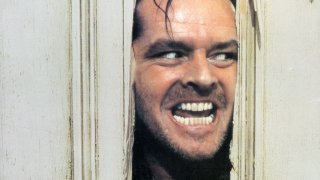
A man previously convicted of bank robbery in New Jersey will get a new trial after the state's highest court objected to a bit of Hollywood flair that appeared during the first trial.
The New Jersey Supreme Court ruled Tuesday that a Camden County prosecutor erred by including a photo of Jack Nicholson from the 1980 classic "The Shining," in her closing argument.
In the iconic scene in the film adapted from a Stephen King novel, the crazed Jack (also the name of his character Nicholson plays) wields an axe as his wife and child hide in a bathroom. He breaks down a piece of the bathroom door with the axe, and sticks his head through the opening, saying "here's Johnny!"
At Damon Williams' trial for an alleged 2014 robbery, the prosecutor showed a frame from the axe scene in her closing argument.
Get top local stories in DFW delivered to you every morning. Sign up for NBC DFW's News Headlines newsletter.
A summary from the Supreme Court's clerk explains the prosecutor was arguing "actions speak louder than words" and that Williams put a Bank of America teller in fear of harm when he handed her a note demanding cash. That was key to the case: if the jury found the teller was at risk of harm, they could find Williams guilty of second-degree robbery by threat of force, instead of a lower charge of third-degree theft.
According to the evidence summarized by the court, Williams' note to the teller read: “Please, all the money, 100, 50, 20, 10. Thank you.”
Court records said Williams never showed a weapon or threatened to use one.
U.S. & World
The teller handed Williams more than $4,600, and tried to include a pack of $20 bills that include a GPS tracker and a device that would trigger a silent alarm. Williams told her not to include that pack of bills, the court said.
The photo of Nicholson did not come up prior to the closing arguments in the trial. The jury found Williams guilty of robbery and he was sentenced to 14 years in prison.
"The prosecutor here nevertheless asked the jury to infer from the photograph and the words 'Here’s Johnny!' that defendant’s words and 'actions' purposefully put [the teller] in fear of immediate bodily injury," Supreme Court Justice Lee Solomon wrote in the court's opinion.
"The prosecutor here went far beyond the evidence to draw a parallel between defendant’s conduct and that of a horror-movie villain," Solomon added later.
You can read the court's full opinion here.



